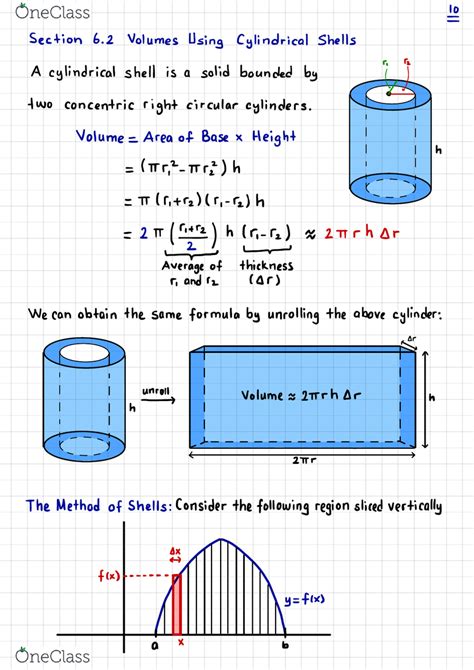Introduction

Calculating the volume of complex shapes can be a daunting task. The volume by cylindrical shells method offers a practical and efficient approach to determining the precise volume of solids with rotational symmetry. This calculator automates the process, enabling users to swiftly and effortlessly obtain accurate volume estimations.
How Does the Volume by Cylindrical Shells Calculator Work?
The volume by cylindrical shells calculator utilizes the concept of cylindrical shells to compute the volume of a solid of revolution. It integrates the volume of infinitesimally thin cylindrical shells that make up the solid. The formula applied by the calculator is:
V = 2π∫[a,b] r(x) h(x) dx
where:
- V is the volume of the solid
- a and b are the lower and upper limits of integration
- r(x) is the radius of the cylindrical shell at height x
- h(x) is the height of the cylindrical shell at height x
Applications of the Volume by Cylindrical Shells Calculator
The volume by cylindrical shells calculator finds widespread application in various fields, including:
- Engineering: Designing and analyzing machine components, fluid flow systems, and architectural structures
- Physics: Calculating the volume of rotating objects, such as spinning tops and celestial bodies
- Mathematics: Exploring the properties of volumes of revolution and developing new mathematical techniques
Benefits of Using the Calculator
- Accuracy and Precision: The calculator employs numerical integration techniques to provide accurate volume estimations.
- Efficiency: It automates the complex integration process, saving users time and effort.
- Flexibility: The calculator handles a wide range of solids of revolution defined by various functions.
- Educational Value: It serves as a valuable tool for students and professionals to understand the concept of cylindrical shells and its application in volume calculations.
Motivations and Pain Points
- Complex Calculations: Manually calculating the volume of solids of revolution using the cylindrical shells method can be tedious and error-prone.
- Time Constraints: Engineers, scientists, and students often face tight deadlines, necessitating a fast and efficient method of volume estimation.
- Accuracy Requirements: Precise volume calculations are crucial in various applications, such as spacecraft design and fluid dynamics.
Pros and Cons
Pros:
- Accurate and precise volume estimations
- Efficient and time-saving
- Flexible and adaptable to a wide range of functions
- User-friendly interface
- Educational value
Cons:
- Requires the function defining the solid of revolution
- Limited to solids of revolution with rotational symmetry
- May encounter numerical errors for complex functions
FAQs
- What is the accuracy of the calculator?
The calculator employs numerical integration techniques, which typically provide accurate results. However, the accuracy can vary depending on the function used and the integration settings.
- Can the calculator handle functions with discontinuities?
Yes, the calculator can handle functions with discontinuities. However, the integration method used may affect the accuracy of the result in such cases.
- What is the ideal function format for the calculator?
The calculator accepts functions in the form of mathematical expressions or equations. It is recommended to use a function format that is continuous and easily integrable.
- How can I ensure the calculator’s results are reliable?
To verify the reliability of the results, users can compare them with analytical solutions or approximations obtained using other methods.
- Can the calculator be used to determine the volume of non-symmetrical shapes?
No, the volume by cylindrical shells calculator is specifically designed for solids of revolution with rotational symmetry.
- Is the calculator available online or as a standalone software?
The calculator is typically available as an online tool accessible through various websites. Some users may also develop their own standalone software implementations.
Table 1: Comparison of Volume by Cylindrical Shells Calculator with Other Methods
| Method | Accuracy | Efficiency | Flexibility |
|---|---|---|---|
| Cylindrical Shells Calculator | High | High | Good |
| Manual Integration | Moderate | Low | Excellent |
| Numerical Approximation | Variable | Moderate | Good |
Table 2: Volume of Common Solids of Revolution Calculated Using the Cylindrical Shells Method
| Solid | Lower Limit | Upper Limit | Radius | Height | Volume |
|---|---|---|---|---|---|
| Cone | 0 | h | x | h-x | (1/3)πr²h |
| Hemisphere | 0 | r | rcos(x) | rsin(x) | (2/3)πr³ |
| Paraboloid | 0 | h | x | x²/(2h) | (πr³h)/2 |
Table 3: Applications of the Volume by Cylindrical Shells Calculator in Different Fields
| Field | Application |
|---|---|
| Engineering | Design of turbine blades, spacecraft fuel tanks |
| Physics | Calculation of the volume of spinning tops, celestial bodies |
| Mathematics | Exploration of volumes of revolution, development of mathematical techniques |
Table 4: Creative Applications of the Volume by Cylindrical Shells Calculator
| Application | Description |
|---|---|
| Volumetric Analysis of 3D Scans: Measure the volume of complex objects captured using 3D scanning technology, such as artifacts, sculptures, and medical models. | |
| Shell Thickness Estimation: Determine the average thickness of cylindrical structures, such as pipelines, by measuring the volume of the cylindrical shell between two surfaces. | |
| Biomedical Fluid Dynamics: Calculate the volume of blood flow through arteries and veins using the cylindrical shells method to model the cross-sectional area of the vessels. |
